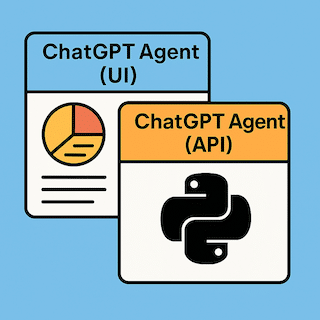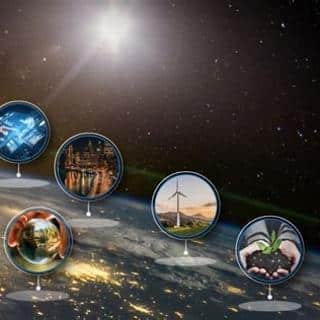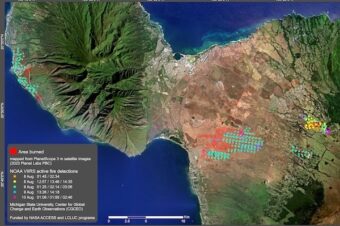Led by Flinders University’s Dr Paul Gardner-Stephen, the Serval Project – named after a problem-solving African wildcat – aims to provide fast, cheap, robust and effective telecommunications systems where conventional phone infrastructure has been destroyed or is not cost-effective.
There are many situations and places where telephone infrastructure is damaged by bushfire, earthquake, tsunami or unrest, or where no infrastructure exists – where conventional networks are of less value,” Dr Gardner-Stephen said. “We are aiming to fill that void.”
The Serval Project consists of two systems.
The first is a temporary, self-organising, self-powered mobile network for disaster areas, formed with small phone towers dropped in by air.
The second is a permanent system for remote areas that requires no infrastructure and creates a mesh-based phone network between Wi-Fi enabled mobile phones, and eventually specially designed mobile phones that can operate on other unlicensed frequencies, called Batphone. The two systems can also be combined.
We have developed software which we’ve called Distributed Numbering Architecture (‘DNA’) that allows people in isolated or temporary networks to immediately use their existing phone numbers.
We believe that for a phone network to be useful, you must be able to call people, and have people call you on numbers that they know. This is especially true in disasters. This is the magic of DNA: it allows people to use their existing phone numbers, so that others can call them easily.
By integrating DNA with existing mesh network technology developed by Village Telco with unlicensed wireless spectrum, Dr Gardner-Stephen and his team will be able to provide telephone access to literally millions of people who currently lack any or affordable telephone coverage, as well as being able to help those affected by disaster.
“It will allow people in remote or isolated townships, or farm workers in network black spots to talk to each other,” he said.
“People in a disaster ravaged area will be able to contact friends and family and aid workers will be better able to coordinate relief efforts.”
Professor Paul Arbon, Director of Flinders University’s Research Centre for Disaster Resilience and Health said recently the Serval Project addresses several key emerging issues in the management of disasters and emergencies.
“The impact of disasters is increasing as more people live in locations where they are at risk and become more dependent on essential societal infrastructure,” Professor Arbon said.
“During disaster, most of the response capacity comes from within the local community with community members rescuing others. Mobile phones provide an important part of this response. They can be used to maintain the connections between family members, to alert and coordinate volunteers and, most importantly, can be used to provide the community with warnings and updates,” he said.
“The Serval Project provides a novel strategy to sustain mobile phone communications where other systems have been knocked out or overwhelmed by traffic on the system.”
The US$1000 Fellowship, provided by the Awesome Foundation’s Boston Chapter, will enable the project team to demonstrate a prototype of the system in coming weeks.
Dr Gardner-Stephen said that with adequate financial support, the systems could be fully operational within 18 months.
Related articles by Zemanta
- New Cell Network Doesn’t Depend on Towers (livescience.com)
- New tech for mobiles may aid rescuers (news.theage.com.au)
- THIS WOULD SEEM TO HAVE OBVIOUS DISASTER-RESPONSE IMPLICATIONS: New project enables mobile phone us… (pajamasmedia.com)
- Software enables cell phones to communicate where there is no reception (textually.org)
- 5 more fresh articles…
Paul Garrett Hugel
Technology Test Pilot
ORCID iD: 0000-0001-8082-7208 Paul Garrett Hugel on BlueSky @paul.nko.org
Latest posts from Paul Garrett Hugel
- Privacy-Preserving Data Collaboration: OpenMined Overview - November 16, 2025
- 🚨 The “No Kings” Protests: - October 18, 2025
- Environmental Groups Condemn EPA Plan to Rescind 2009 Climate Finding - July 29, 2025
Recent Posts
Privacy-Preserving Data Collaboration: OpenMined Overview
Unlocking Secure Data Collaboration: A Technical Introduction to OpenMined 1. How Privacy-Preserving Data Collaboration Solves... Read More
🚨 The “No Kings” Protests:
This week, something historic happened: nearly seven million people across 40+ countries marched against Donald Trump’s administration... Read More
Environmental Groups Condemn EPA Plan to Rescind 2009 Climate Finding
Executive Summary On July 29, 2025, EPA Administrator Lee Zeldin announced the agency’s intent to rescind the 2009... Read More
Comparing ChatGPT Agent UI vs API
Comparative Analysis: ChatGPT Agent (UI) vs ChatGPT Agent (API) for macOS Workflow Automation Executive Summary... Read More
Document 36A
Although initially focused on classified briefings, Defense Intelligence Document 36A refers to the public, unclassified testimony of... Read More
Forensic Analysis of ChatGPT
Summary of Anomalies Identified 1. Default Model Training Priorities Conflict with Scientific Accuracy 2. Memory... Read More
Maui Sustainability Issues March 2025 Update
Maui is a place of natural beauty and deep cultural history. But today, the island... Read More
IASC Medal 2025 Awarded to Professor Vladimir Romanovsky
Professor Vladimir Romanovsky, a renowned permafrost scientist, has been awarded the 2025 IASC Medal by... Read More








Leave a Reply